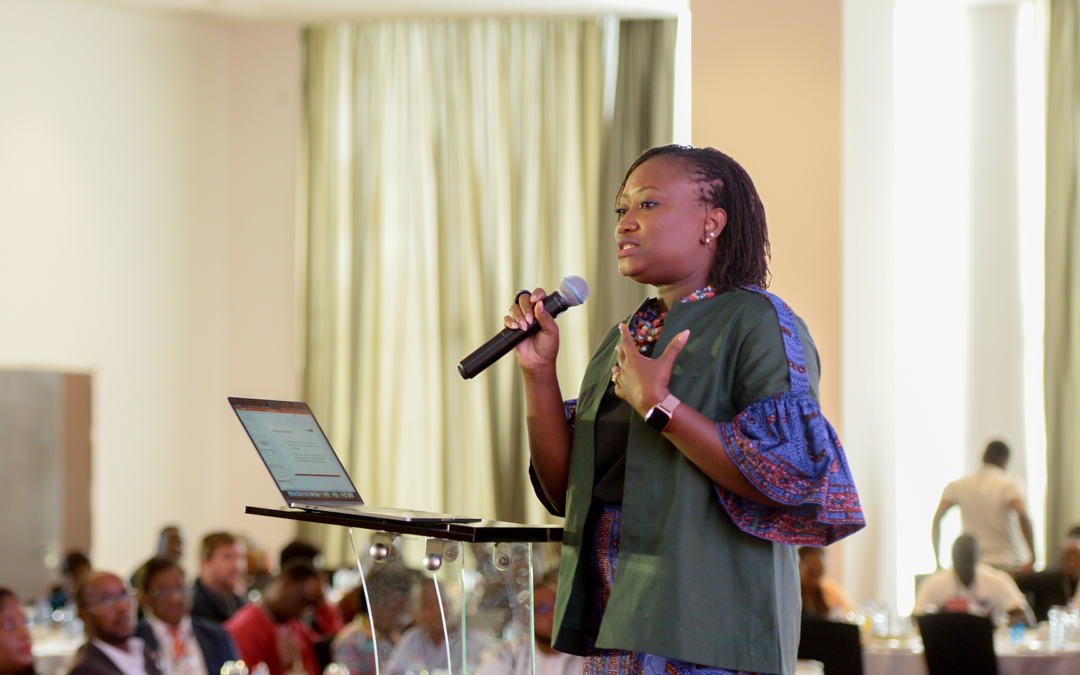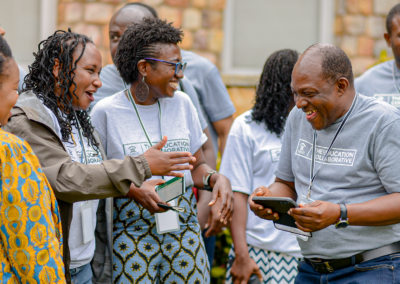Annual Convening 2022
University Stakeholder Symposium
Accra Marriott Hotel
Rose Dodd, Director, The Education Collaborative
16th June
Thank you so much, once again, for being here with us this morning. It is exciting to have you all here in person for two reasons: First because the past two years have been virtual, so in 2020, we had The Education Collaborative Annual Convening online; our very first time trying to create this connection and engagement online and still bring some warmth to it. In 2021, we did it again online, very successfully. And so, seeing everyone here again in person to meet, connect, and engage with each other makes us very happy.
The second thing is, in 2017, when The Education Collaborative was just an idea, we were figuring out what this network should look like, determining what matters to higher education institutions and what would be valuable to individual institutions and the collective on the continent. We had together in a room at Ashesi University, 25 individuals. And today, we have together over 300 participants joining in-person and online. That’s a strong indicator of the need for such a network.
There are several networks on the continent that engage higher education institutions, and across other continents in different countries that engage higher education institutions. What makes The Education Collaborative different? There is a quote from Ashesi University President, Dr Patrick Awuah’s TED talk in 2019: “This project of transforming Africa is not going to be done not by one institution, but by a thousand. We need to build a network of like-minded institutions. Ashesi is a self-contained system, and in order to transform African leadership, we need entire systems working together.” Similar to indigenous African proverbs, cultures and beliefs, when you go alone, you can go fast, but by going together, we can go further. This quote has been one of the driving forces at The Education Collaborative. We have been determining how to build deeper connections and relationships to collectively make an impact for higher education institutions and the entire higher education sector in Africa to improve. Ensuring that higher education on the continent as a whole rises together.
We have one bold vision, and it’s a very bold vision: Increased ethical entrepreneurial graduates with skills, knowledge and character to be good citizens and to lead institutions and economies in Africa. Broadly, the products of higher education in Africa should be ready with the required skills, the required character, the ability, the passion for going into government, the public sector, the private sector, starting their businesses and driving the continent’s developments. We want to get ahead of it and not chase after it so that we can shape the way we want Africa to develop.
In 2017, we began thinking through how we could achieve this. Our pilot years were between 2017 and 2020. From 2017 to 2020, we gauged interest. We determined whether African institutions and the sector want to collaborate and how institutions wish to collaborate. We learned a lot, and I will share that briefly.
In 2018, we started testing out cross-institutional mentorship and coaching, deliberately pairing institutions with others who want to share and learn knowledge in different areas. We did that for over two years. From 2019 through 2020 and now, we started focusing on project-based sharing because we learned that sometimes institutions have specific parts of their system that need support. Based on learnings from the engagement over the past years, we noticed trends that all higher education institutions and the sector at large were working towards; employability, entrepreneurship, faculty development, and research. These areas formed our focal initiatives at The Education Collaborative, and they drive our engagements across different institutions.
At the start of 2020, we began to structure and define how we engage in The Education Collaborative, outlining what the governance and institutional engagements look like. We then came up with the term “exemplar institutions”. These institutions have shown exemplary evidence of good outcomes in specific areas and support others who want to learn in these areas.
With these learnings, we created a network which rolled out formally in 2021. We began focusing on building deeper connections, relationships, and a more profound impact. These two make The Education Collaborative unique compared to other networks on the continent and even across higher education in the world. For us, it’s not about the numbers but the depth of impact. In our ultimate goal, we estimate that even if 20 higher education institutions on the continent become fully committed to this vision, we can directly transform over a million students. Suppose the 20 institutions engage other higher education institutions through mentorships, and the mentor and mentee institutions share their learnings, capture evidence, and communicate with regulators and financiers. In that case, we can still achieve our goal.
And this was per our estimations. We learned that focusing on deeper impact takes us further than engaging on the surface level and growing too big too quickly. This drives The Education Collaborative’s mandate. I’ll share a few numbers with you. Participation in our Annual Convenings has grown from 25 to over 300 now. Since 2017, we have grown from 12 higher education institutions. This year, it’s over 60 institutions, with a little over 50 being higher education institutions and other institutions in the higher education sector.
Out of the 1.1 million students we are trying to reach by 2030, from our pilot years till now, we have directly impacted over 116,000 students. This is how we estimate our numbers. Suppose a faculty member in an institution was in a development session or training program led by The Education Collaborative events and continually received support and resources to improve their teaching. In that case, we are counting the students they are impacting. If executive members receive coaching on policy updates on systematic changes, then we also count the students and faculty they are impacting. With member institutions, we aim to have 140 consortium member institutions in The Education Collaborative. We are looking to engage over 1400 higher education institutions on the continent in The Education Collaborative open network. However, with member institutions driving the mandate, we are looking at about 140, and currently, we have reached 16 institutions. We have also engaged with over 30 higher education leaders and executives.
As Prof. Angela Owusu-Ansah said, we have successfully launched the East Africa regional hub. We will soon formally launch the West Africa regional hub. Over the past few years, we have deepened cross-institutional connections in The Education Collaborative. Ten higher education institutions with a combined student population of about 30,000 in the East African region joined the regional hub to discuss the strategic implementation of The Education Collaborative’s vision in the region. Our hope is that, as these institutions begin to engage and develop a content strategy around how to push this vision in the East African region, we will be able to reach those 30,000 students and more.
Sometimes, institutions reach out to my office or the network, saying they want to set up their career services office and need support to figure out how to set it up, or they are trying to recruit a new executive board and need help on how to go about it. We then connect with one, two, or sometimes three institutions that have said they have the expertise and are ready to contribute it to the larger network. We have done that several times over the last four to five years.
We have successfully established four communities of practice. As of 2021, we had just one at the beginning of 2021, and by the end of the year, we had added three more communities of practice. And these have been in the areas of entrepreneurship, ethics and leadership, research development and employability. Between 2020 and 2021, we supported a member institution to raise over $30 million, based on the support they received from our Education Collaborative Mentorship Program. Through the mentorship they received from Ashesi University and other universities across the continent, this institution was able to prepare its strategies, staff, faculties, and executive team members to raise over $30 million to support its growth.
The Education Collaborative also looks at pre-tertiary education in a way that is easily accessible across the continent. We partner with institutions that focus on pre-tertiary education. Until now, we have been working with an organization on Hands-on Science training for junior and senior high school science teachers. Through this partnership, we directly trained 45 high school teachers in four regions in Ghana. In the next couple of years, we are looking to expand this to thousands more in other countries in West and East Africa. Here, you can learn more about The Education Collaborative’s outcomes on our outcomes report page.
But the goal here, and I’ll reiterate, is the depth of impact. Institutions that have become members of The Education Collaborative consortium are committing to an expansive vision, a huge goal, where they will be willing to share learnings with higher education institutions who need help to improve aspects of their systems or strategies. This is the end of my report. Thank you very much.



